

Receive Email Updates
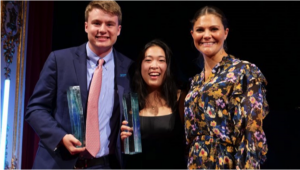
New York high school students Ryan Thorpe and Rachel Chang, receive the 2017 Stockholm Junior Water Prize from H.R.H. Crown Princess Victoria of Sweden in Stockholm
Photo credit: The Stockholm International Water Institute
At this summer’s Stockholm International Water Institute’s World Water Week meeting, two New York high school students were awarded the Stockholm Junior Water Prize for their rapid contaminant detection and water purification system. Ryan Thorpe and Rachel Chang accepted the prize from Crown Princess Victoria of Sweden at the August festivities.
The students engineered graphene-based biosensors to detect minute levels of specific bacteria in less than one second, a great improvement over conventional methods, which can take one to two days. An added bonus: The biosensors can detect as few as one colony forming unit (CFU) of bacteria. Other rapid DNA detection methods often require 1,000 CFUs.
The water purification part of the system is achieved by injecting hydrogen peroxide and sodium hydroxide into contaminated water. These chemicals react to produce hydroxyl free radicals, short-lived, highly reactive chemical species composed of oxygen and hydrogen. Hydroxyl free radicals eliminate organic matter (e.g., bacteria) in the water, producing carbon dioxide and water. Dr. Joan Rose, the 2016 recipient of the Stockholm Water Prize congratulated the “highly impressive and articulate young people,” noting, “The creative energy with which they have tackled a significant global challenge is exactly what the world community needs to get us to a better world for all.”
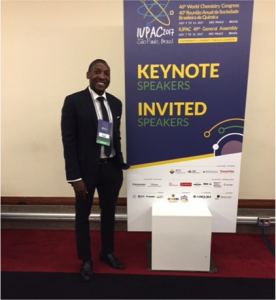 Responding to the theme of the 2017 World Chemistry Congress, “Sustainability and Diversity in Chemistry,” Mr. Wesley Laine, founder of Haiti-Philanthropy, presented “Chlorination of Haiti’s Drinking Water – A Sustainable Model for Developing Countries,” at the Congress on July 11, 2017. Mr. Laine, a 2017 graduate of Harvard Law School, described his work installing simple chlorinator devices that utilize “hockey puck” tablets of calcium hypochlorite to disinfect drinking water in the rural southeast of Haiti. Drinking water chlorination destroys most waterborne pathogens, including Vibrio cholera, the bacteria inadvertently introduced by UN peacekeepers after an earthquake that devastated Haiti in 2010. Mr. Laine noted that community involvement in maintaining chlorinators and purchasing chlorine tablets through a “chlorine bank” is key to developing a sustainable system of safe drinking water provision. Haiti-Philanthropy is supported in part by the American Chemistry Council’s Chlorine Chemistry Division.
Responding to the theme of the 2017 World Chemistry Congress, “Sustainability and Diversity in Chemistry,” Mr. Wesley Laine, founder of Haiti-Philanthropy, presented “Chlorination of Haiti’s Drinking Water – A Sustainable Model for Developing Countries,” at the Congress on July 11, 2017. Mr. Laine, a 2017 graduate of Harvard Law School, described his work installing simple chlorinator devices that utilize “hockey puck” tablets of calcium hypochlorite to disinfect drinking water in the rural southeast of Haiti. Drinking water chlorination destroys most waterborne pathogens, including Vibrio cholera, the bacteria inadvertently introduced by UN peacekeepers after an earthquake that devastated Haiti in 2010. Mr. Laine noted that community involvement in maintaining chlorinators and purchasing chlorine tablets through a “chlorine bank” is key to developing a sustainable system of safe drinking water provision. Haiti-Philanthropy is supported in part by the American Chemistry Council’s Chlorine Chemistry Division.
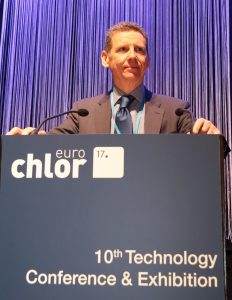
Chris Allen from the European Commission praised chlor-alkali’s efforts in the mercury phase out…
Euro Chlor held its tenth Technical Conference & Exhibition in May 2017; sharing best practices and new technological developments in the areas of health, safety and environmental protection.
Chairman of the Euro Chlor Management Committee Dieter Schnepel (Dow Deutschland) opened this Berlin edition of the Conference, welcoming 360 participants from 34 countries to the theme: sustainable chlorine production and the road to continuous improvement. He highlighted that our industry will continue to develop in the years ahead of us, as not only will mercury technology for the production of chlorine, caustic and hydrogen soon disappear, but our high energy demand – inherent to the chlor-alkali production – means we need to find increasingly efficient and sustainable ways of producing energy.
These and many other topics returned during the conference and in the exhibition, with 46 exhibitors presenting their equipment and those services they offer to our industry. Apart from the mercury challenge, issues like the effects of EMF directives on our industry and the protection of our worker’s physical and mental health were some of the many discussed subjects. Within the mercury context, Christopher Allen, Head of the Industrial Emissions and Safety Unit at the European Commission, presented the regulatory framework on the mercury subject. He also expressed his appreciation for our industry’s collaboration, openness and willingness to share mercury information.
This global, collaborative concept closed out the conference where Euro Chlor executive director Dolf van Wijk stated that “transparency and working together is one of our shared key values”.
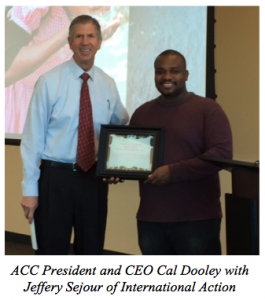 In 1993, the United Nations designated March 22 as World Water Day. Almost 25 years later, efforts to tackle difficult global water problems continue. This year’s theme is “why waste water?” Globally, the vast majority of wastewater—from homes and communities—flows back to the environment untreated or reused, contributing to contaminated drinking water while losing valuable nutrients and other recoverable materials. The UN Sustainable Development Goal (SDG) 6 aims to “Ensure availability and sustainable management of water and sanitation for all.”
In 1993, the United Nations designated March 22 as World Water Day. Almost 25 years later, efforts to tackle difficult global water problems continue. This year’s theme is “why waste water?” Globally, the vast majority of wastewater—from homes and communities—flows back to the environment untreated or reused, contributing to contaminated drinking water while losing valuable nutrients and other recoverable materials. The UN Sustainable Development Goal (SDG) 6 aims to “Ensure availability and sustainable management of water and sanitation for all.”
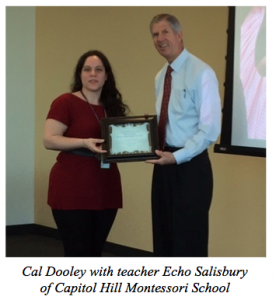
As part of the celebration of World Water Day, the American Chemistry Council (ACC) welcomed 35 elementary school students from the Capitol Hill Montessori School in Washington, DC. Jeffrey Sejour of International Action, which is working to chlorinate drinking water in Haiti, spoke with the students about water and wastewater problems that continue to plague Haitians. The students also video-conferenced with Andrew Coco of Pure Water for the World from their water quality laboratory in Port-au-Prince, Haiti. The event concluded with a hands-on water chemistry experiment to measure the presence of residual chlorine in water to see which samples were disinfected and thus safe to drink. In recognition of their ongoing efforts to provide safe drinking water, ACC’s Chlorine Chemistry Division donated $5,000 to International Action on behalf of the students of Capitol Hill Montessori School.

The theme of this event is “Sustainable chlorine production; the road to continuous improvement” and participation is open to both Euro Chlor members and non-members alike.
Given the global chlor-alkali industry emphasis on safety and the environment and, as for previous events, health, safety and environmental protection in the production, use and transport of chlorine will constitute the core of the Conference. There will also be additional attention on those technologies and services that safely, sustainably and responsibly drive the chlor-alkali industry forwards.
In parallel with the Conference, an Exhibition will give engineering companies, equipment manufacturers and service suppliers the opportunity to showcase their expertise and the benefits they can offer to the participants.
At the 2014 event in Madrid, over 370 delegates from 34 countries from around the world attended and it is hoped that participation will be even higher this year!
This new Conference will be held at the Maritim Hotel Berlin, close to Postdamer Platz in Berlin, and accommodation for the participants will be available in the hotel itself.
You can find detailed information on the Conference program, exhibition participation and registration requirements on this dedicated website: http://eurochlor2017.org/.
Additional information can be obtained from contact[at]eurochlor2017.org.
Contact Euro Chlor: Chantal Peeters, Technical Assistant, cpe[at]cefic.be , tel. +32 2 676 74 01
“From the salt of the Earth” come hundreds of useful products that make life in the 21st century possible. How so?
Salt, extracted from the deposits of ancient seas, along with water and electricity, are the three ingredients from which two widely used commodity chemicals are produced.
Those chemicals, chlorine and sodium hydroxide, play a significant role in the manufacture of products such as life-saving pharmaceuticals, PVC medical devices, silicon chips for computers, solar panels, wind turbines, titanium metal for artificial joint replacements, water treatment chemicals, fiber optic cables, aluminum, paints, and much more…
The American Chemistry Council’s (ACC’s) Chlorine Chemistry Division recently updated its Chlorine and Sodium Hydroxide Product Trees. Access the Chlorine Product Tree and the Sodium Hydroxide Product Tree to explore a multi-faceted chemistry based on “the salt of the Earth.”
In September 2015, the new UN Agenda for Sustainable Development was adopted, coming into force on 01 January 2016. The 17 Sustainable Development Goals (SDGs) contain a very important one, SDG #6 (Sustainable management of water and sanitation for all) which is of direct relevance to chlorine. The importance of SDG #6 was highlighted during the 2016 World Water Week, which this year took place on 27 August – 01 September.
Despite some progress in achieving the SDGs being made, the UN Secretary General report of June 2016, highlighted that some areas for improvement still remain. For example by 2030, 663 million people could still have no access to an improved water source and 2.4 billion people may still have no access to improved sanitation. This must change over the next 15 years and efforts to do this have begun by making the SDG indicators more specific and measurable.
It is here that chlorine plays a vital role! For example, the SDG indicators call for improved drinking water sources that are located on the premises, available when needed and compliant with water quality standards.
Chlorine is already well known to be a powerful tool in providing such safe supplies. For example, in 2012 “Rapid Assessment of Drinking-water Quality: A Handbook of Implementation” (WHO/UNICEF) recommended the use of the chlorine residual of ≥ 0.2 mg/l as a key parameter to check for in all samples from disinfected supplies (e.g. at treatment works, in distribution and in households). This residual helps to protect the microbial quality of the water in distribution and storage in order to safeguard human health.
This residual is not the only benefit of using chlorine though. Chlorine’s affordability and proven, effective nature, alongside it’s scalability and ease of measurability using simple test-strips will all contribute to achieving the UN SDGs over the coming years.
Indeed, such positive impacts are already seen in Haiti, where a network of ‘Chlorine Banks’ is helping to protect over 900,000 people in rural communities from fatal waterborne diseases like cholera for as little as 20₵ per family per month!
CLOROSUR is pleased to invite you to participate in the X International Technical Seminar and Table Top Expo to be held on November 16 – 18, 2016 in Buenos Aires/Argentina. Back-to-back with the Technical Seminar, on Friday, November 18 the World Chlorine Council Global Safety Team (WCC GST) will hold its Safety Workshop focused on Process Safety Management (PSM).
Parallel to the CLOROSUR Technical Seminar and WCC Safety Workshop, a Table Top Expo featuring technology suppliers, materials and equipment manufacturers, as well as companies that provide services to the Chlor-alkali industry will allow participants to meet their representatives.
In addition to the technical sessions and exposition, participants that are interested will be able to visit CLOROSUR member company TRANSCLOR facilities located at Pilar, 40 km from Buenos Aires on Wednesday morning November 16. CLOROSUR will provide ground transportation from the Hilton Hotel to the plant and back. On the evening of the 16th a Welcome Cocktail will be held by the Hotel’s pool.
The entire program above will take place at the HOTEL HILTON in Buenos Aires/Argentina, with accommodation available at a special rate for participants.
If you have any question please contact Martim A. Penna at mpenna@clorosur.com.br or Mrs. Lucimara Murakami at lucimara@clorosur.com.br, phone number (55 11) 2148-4780 and Meaghan Groah at Meaghan_Groah@americanchemistry.com, phone number (O: 202-249-6716 – C: 717-333-1495).
September 26 marked the 108th anniversary of the first continuous use of chlorine to disinfect a public drinking water supply in the United States, notes a Water Quality & Health Council (WQ&HC) Perspectives article (September 23). In an extensive feature story, the WQ&HC notes that in 1908, “chlorine chemistry’s germ-defeating properties were demonstrated in drinking water in two very different settings in the United States. ”First, a test of chlorination improved the quality of animal feed water, drawn from a highly polluted stream in Chicago’s Union Stockyards”, states the story. “Days later, in Jersey City, chlorinated water was supplied for the first time on a permanent basis to a large U.S. municipality. The results included a dramatic decline in the local typhoid fever rate and a water supply that, according to a 1928 sanitary engineering report, ‘is not only of a high sanitary quality, but…it compares favorably with the best in the country,’” according to the story. “Good news traveled quickly and within a decade, drinking water chlorination spread to nearly every large city in the country. It has been called ‘a tremendous boon in the safeguarding of public health all over the world and is probably the most important and efficient sanitary measure of protection ever introduced.’” Contact: Mary Ostrowski, 1-202-249-6705.
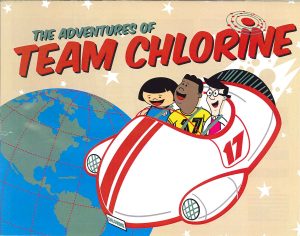 A fun and colourful new activity book and website were released today by the Chlorine Chemistry Division of the American Chemical Council.
A fun and colourful new activity book and website were released today by the Chlorine Chemistry Division of the American Chemical Council.
Designed by Meaghan Groah of the ACC, this wonderful new book and website is for children of all ages. It helps to educate on how chlorine is a positive part of our daily lives that is present in important products and applications from all over the world. From solar panels to herbicides, modern plastics to protecting metal, the book is full of exciting stories that everyone can enjoy. You can even try learning about chlorine whilst colouring in the pictures online!
Check out the exciting adventures of Team Chlorine via the website teamchlorine.org!